Giovanni Paolo Panini
Giovanni Paolo Panini or Pannini (17 June 1691 – 21 October 1765) was a painter and architect who worked in Rome and is primarily known as one of the vedutisti ("view painters"). As a painter, Panini is best known for his vistas of Rome, in which he took a particular interest in the city's antiquities. Among his most famous works are his view of the interior of the Pantheon (on behalf of Francesco Algarotti), and his vedute—paintings of picture galleries containing views of Rome. Most of his works, especially those of ruins, have a fanciful and unreal embellishment characteristic of capriccio themes. In this they resemble the capricci of Marco Ricci. Panini also painted portraits, including one of Pope Benedict XIV.[1]
Giovanni Paolo Panini | |
|---|---|
 Portrait of Panini by Louis Gabriel Blanchet | |
| Born | 17 June 1691 |
| Died | 21 October 1765 (aged 74) |
| Nationality | Italian |
| Known for | painter |
Notable work | veduta |
Biography
As a young man, Panini trained in his native town of Piacenza, under Giuseppe Natali and Andrea Galluzzi, and with stage designer Francesco Galli-Bibiena. In 1711, he moved to Rome, where he studied drawing with Benedetto Luti.
In Rome, Panini earned a name for himself as a decorator of palaces. Some of his works included the Villa Patrizi (1719–1725), the Palazzo de Carolis (1720), and the Seminario Romano (1721–1722). In 1719, Panini was admitted to the Congregazione dei Virtuosi al Pantheon. He taught in Rome at the Accademia di San Luca and the Académie de France, where he is said to have influenced Jean-Honoré Fragonard. In 1754, he served as the prince (director) of the Accademia di San Luca.
The Spanish monarchs appreciated his work in such a way that, commissioned by Filippo Juvarra, he sent paintings to decorate the Lacquer Room of the Royal Palace of La Granja de San Ildefonso. In addition, King Carlos IV, when he was Prince, bought several of his works that are still preserved in the Prado Museum and in the royal palaces.[2]
Panini died in Rome on 21 October 1765.[1]
Legacy
Panini's studio included Hubert Robert and his son Francesco Panini. His style influenced other vedutisti, such as his pupils Antonio Joli and Charles-Louis Clérisseau, as well as Canaletto and Bernardo Bellotto, who sought to meet the need of visitors for painted "postcards" depicting the Italian environs. Some British landscape painters, such as Marlow, Skelton and Wright of Derby, also imitated his capricci.
In addition to being a painter and architect, Panini was a professor of perspective and optics at the French Academy of Rome. His masterful use of perspective was later the inspiration for the creation of the "Panini Projection", which is instrumental in rendering panoramic views.
Gallery
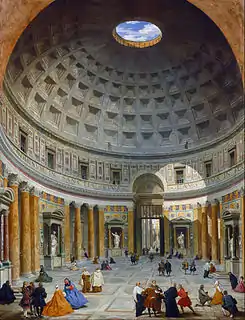 Interior of the Pantheon, Rome, c. 1734
Interior of the Pantheon, Rome, c. 1734 Saint Paul Preaching in Athens, 1734, National Gallery of Art
Saint Paul Preaching in Athens, 1734, National Gallery of Art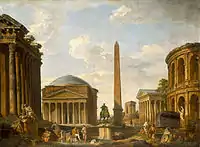
 A Capriccio of the Roman Forum (1741)
A Capriccio of the Roman Forum (1741)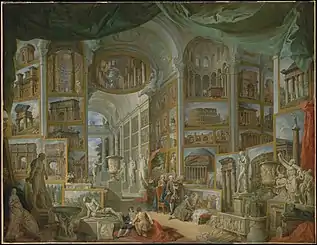
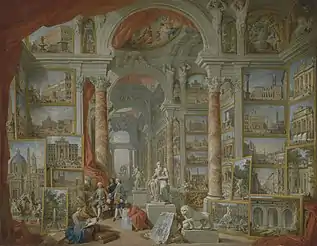
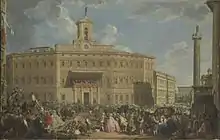 The Lottery at Palazzo Montecitorio, now in the National Gallery, London
The Lottery at Palazzo Montecitorio, now in the National Gallery, London St. Peter's Basilica, from the entrance
St. Peter's Basilica, from the entrance Adoration of the Shepherds, Adoration of the Magi (1755), shown here at the Brooklyn Museum in New York City
Adoration of the Shepherds, Adoration of the Magi (1755), shown here at the Brooklyn Museum in New York City View of the Colosseum (1747), at The Walters Art Museum
View of the Colosseum (1747), at The Walters Art Museum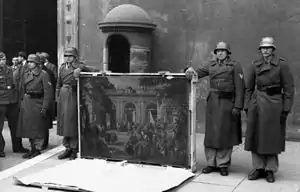 German soldiers in 1944 posing with a Pannini picture – Carlo III di Borbone che visita il papa Benedetto XIV nella coffee-house del Quirinale a Roma – at the time looted from the Naples Museum
German soldiers in 1944 posing with a Pannini picture – Carlo III di Borbone che visita il papa Benedetto XIV nella coffee-house del Quirinale a Roma – at the time looted from the Naples Museum A Concert Given by the duc de Nivernais to mark the Birth of the Dauphin, 1751 at Waddesdon Manor
A Concert Given by the duc de Nivernais to mark the Birth of the Dauphin, 1751 at Waddesdon Manor Ruins of Ancient Rome
Ruins of Ancient Rome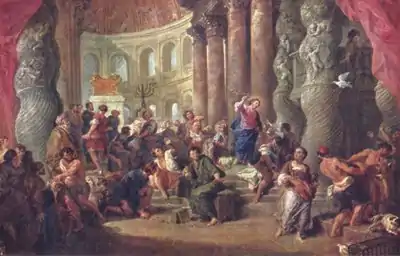

References
- Anna Maria Ferrari. "Panini, Giovanni Paolo." Grove Art Online. Oxford Art Online. 27 March 2010.
- "Panini, Giovanni Paolo - Colección - Museo Nacional del Prado". www.museodelprado.es. Retrieved 28 December 2020.
- "Christ casting the Money Changers out of the Temple - The Collection - Museo Nacional del Prado". www.museodelprado.es. Retrieved 28 December 2020.
- "The pool at Bethesda". Museo Nacional Thyssen-Bornemisza. Retrieved 2020-12-28.
Further reading
- Arisi, Ferdinando (1986). Gian Paolo Panini e i fasti della Roma del '700 [Gian Paolo Panini and events in 18th c. Rome.] (in Italian). ISBN 88-7003-016-4.
- Arisi, Ferdinando,Giovanni Paolo Panini 1691-1765, Milano, 1993.
- Horak, Marco, Ritornato a Piacenza il dipinto di Panini passato all'asta lo scorso anno a Londra: si tratta dell' "opera prima", pendant di quello esposto alla Glauco Lombardi di Parma, in "Strenna Piacentina 2013", Piacenza, 2013.
- Horak, Marco, Quell'opera prima di Panini gemella del dipinto esposto al Lombardi di Parma, in "L'Urtiga - Quaderni di cultura Piacentina", Piacenza, n. 4, 2013.
- Horak, Marco, L'opera prima del Panini in una collezione privata, in "Panorama Musei", anno XVIII, n.3, dicembre 2013
- Horak, Marco, G.P. Panini al Fine Art Museum di San Francisco, in "Panorama Musei", anno XXI, n. 2, settembre 2016
External links
- 68 paintings by or after Giovanni Paolo Panini at the Art UK site
 Media related to Giovanni Paolo Pannini at Wikimedia Commons
Media related to Giovanni Paolo Pannini at Wikimedia Commons- Art and the empire city: New York, 1825-1861, an exhibition catalog from The Metropolitan Museum of Art (fully available online as PDF), which contains material on Panini (see index)
- Europe in the age of enlightenment and revolution, a catalog from The Metropolitan Museum of Art Libraries (fully available online as PDF), which contains material on Panini (see index)
- Capriccio of Roman Ruins with Figures, from the Permanent Collection of the Utah Museum of Fine Arts
- Panini at Waddesdon Manor